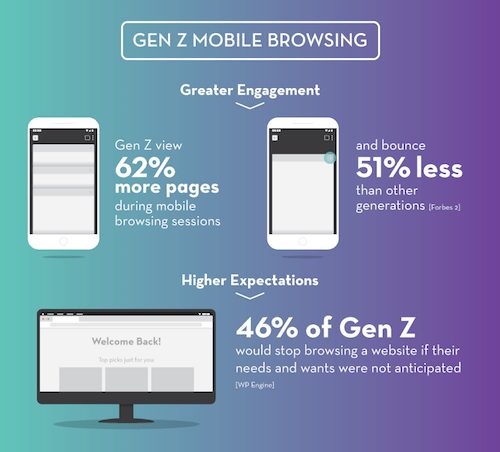How to Reverse Enrollment Losses and Market to Prospective Students
It’s no secret that the COVID-19 pandemic has led to a huge disruption in higher education. Students who would be on their way to a traditional on-campus semester are now taking online classes and adjusting to distance learning.
With over 5,300 colleges and universities in the United States, the competition to attract prospective students is increasing and with the added circumstances of a shifting online student population, online institutions in particular have their own unique challenges when trying to get in front of target audiences.
The COVID-19 pandemic and the red-hot job market have landed a one-two punch on college enrollment numbers. New data from the National Student Clearinghouse Research Center reveals that student head count has shrunk more than 5% since 2019. That’s a total two-year decline of almost 1 million students who either left or never enrolled in college.
Given the grim state of recent student enrollment cycles, higher education institutions nationwide are exploring creative ways to increase student enrollment. But with about 4,000 degree-granting U.S. colleges and universities, the competition to attract prospective students is fierce. Moreover, many higher-ed institutions are grappling with the added circumstances of a shifting online student population and face their own unique challenges when trying to get in front of target audiences.
Whether your university offers online or on-ground programs (or both), attracting prospective students in 2022 and 2023 is going to require innovative and creative marketing strategies.
What Is a Prospective Student?
Prospective students are individuals who are interested in your college or university’s program and are at some level in the student journey funnel.
To prospect effectively, it’s important to understand the search intent and needs of a student at each level of the funnel.
- Awareness — Individuals do not know they want to pursue a degree and may not even be aware of your school.
- Familiarity — Individuals are aware of a higher education institution or degree but haven’t yet decided to pursue it.
- Consideration — Individuals know they want or need to pursue a degree and are considering specific degree programs and institutions. They’re more likely to be familiar with your school and brand.
- Choice — Individuals are ready to choose an institution at which to pursue their degree.
More broadly, there are just two types of prospective students — those who are aware of your school and those who are not. Initially, the goal of higher-ed marketers is for both types of prospective students to choose their college or university. But even if the goal is the same, the approach should be slightly different.
How to Attract Students to Your Institute

Many powerful strategies for marketing to college students can help you to increase their awareness and familiarity with your brand. Here are some creative ways to go about it.
Awareness Tactics
Prospective students who aren’t aware of your school and are still in the shopping-around phase benefit the most from awareness tactics such as paid media and strategic inbound marketing. To increase brand and program awareness, there are a few things colleges and universities should do.
Paid Media
Pay-per-click (PPC) is a great channel to use in order to introduce new prospective students to schools and their programs. It works exactly the same way as when new brands and businesses want to be found by customers.
Google Ads, Bing, LinkedIn, Facebook, and Instagram are the main channels to go for. By creating a strategic lead generating PPC campaign, universities can increase the number of students signing up for programs or seeking more information. The only drawback of using these channels is the cost.
Inbound Marketing
Higher education institutions should also make sure their websites follow on-page SEO best practices. Strategic interlinking throughout program pages and content can help a user feel connected in the ecosystem of your site and be interested in learning more about your brand.
Familiarity Tactics
Students who are aware of your institution most likely have a list of schools and programs they’re interested in. The first place they’ll seek more information is the school’s website. To remain effective, higher education websites should have three things:
Mobile-Friendly Pages
In 2021, desktop internet usage dropped from 54.86% to 48.88%, while mobile usage increased from 37.38% to 47.59%, according to TechJury. That means nearly half of all searchers are going to be looking at your site through their mobile devices, so optimizing for mobile is important.
Having an easy-to-navigate and mobile-friendly website is key not only for a user but also for search engines. Google values and prefers sites that are optimized for a mobile experience.
Valuable and Informative Content
When creating content, schools should never forget whom they’re trying to reach. As such, content should be student-focused and highly relevant to the reader. Text, video, and other forms of content should provide insightful information, tips, best practice guides, news, and other topics of interest. In other words, always consider what a student wants to know rather than what your institution wants to tell them.
It’s useful to think back to the student journey funnel when creating informative content. Speak to students where they are. Top-of-the-funnel students will be attracted to career or broad industry outlook topics, whereas students near the bottom of the funnel will be interested in how their career or degree is related to current events or what kind of direct impact they can have in their field.
Good User Experience
College and university websites are typically large and complex. Simplify the user journey by making sure the website has a clear navigation system, with the most important pages no more than three clicks away from the homepage. The homepage also should have a search box and a request form to facilitate flow through the website and offer a better user experience (UX).
Interlinking is another great tool to leverage. By developing a clear path for the user that is informative and addresses the needs of that user throughout every step of the way, you create a better UX and encourage them to remain on your site longer.
Tips and Tricks for Marketing to College Students
There are many ways to reach out to future students. While traditional methods such as high school visits, college fairs, and print material still have their place, they aren’t enough to make a university stand out from competitors. Connecting and making an impact with today’s prospective students requires a tailored approach to the incoming students’ media habits.
Use Social Media Platforms
Social media is a powerful marketing tool, which is why the online space is so crowded. But getting more than a glance from visitors to platforms like Facebook and Instagram takes strategy and great content.
With nearly 1.1 billion users worldwide in 2021, Instagram is among the most widely used social media platforms across generations and populations — and one of the best avenues for marketing to college students.
Universities can use the platform to share engaging brand images and videos, such as highlights of a school’s location. They can also showcase student life and campus activities and engage with users who comment and share on the platform.
TikTok
TikTok is a relative newcomer that has skyrocketed in popularity among Gen Zers and millennials. Many universities have jumped on the bandwagon to get in front of a younger audience. TikTok can be a way to engage prospective students who want a real look at the student life experience.
Universities can use TikTok to share videos of sports games, campus life, research projects, and new developments in programs. With strategic hashtagging, they can generate a consistent following and have wide appeal to prospective students.
Appeal to Students With Video
While traditional blogs and other written content are still relevant and important for digital marketing, vlogging (posting short videos) is a great way for schools to interact and connect with millennials. Vlogs let viewers immediately engage with current events. Many higher education institutions already publish various content to YouTube, but livestreaming that functions similarly to Snapchat could support the interaction with potential students and alumni right here and right now by showing schools’ events, lectures, and other creative content.
Enlist Influencers and College Ambassadors
Influencers and brand ambassadors are powerful forces in today’s social media-driven marketplace, and higher education is no exception. Gen Zers and millennials both respond well to word-of-mouth marketing (WOMM), often putting more trust in it than in more traditional forms of promotion.
That’s why maintaining close relationships with alumni who can act as influencers and talk up your institution is a great way to attract their followers to your school. Enrollment marketers should consider organizing online or in-person panel-style meetings for prospective students with influencers where alumni share their experiences and answer questions. Capitalizing on these valuable relationships with successful and notable alumni can help promote different school programs and boost brand awareness.
Build a Creative Marketing Strategy to Attract Students
Millennials and Gen Zers gravitate to authentic, creative brands that speak with a clear voice. Today’s digital technologies, social media platforms, and apps present enrollment marketers with countless ways to promote their schools and degree programs and show off their brands to prospective students.
Here at Archer Education, we partner with universities to help higher-ed leaders and marketers accelerate online learning growth. We offer a variety of tech-enabled marketing, enrollment, and retention services. If you’d like to learn more, contact our team and explore our offerings today.



